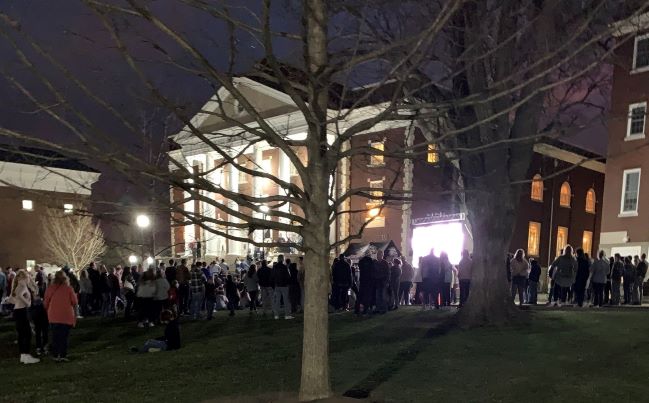Students are worshipping God, praying for one another, reading Scripture, and confessing sins at this event. This is quickly turning into what some are calling the Asbury Revival, and visitors around the globe are presently coming into chapels at Asbury to experience it. On Wednesday, February 8, a routine chapel service at Asbury University in Wilmore, Kentucky continued for hours and hours, and it continues on now, non-stop, more than a week later.
Both the university and seminary chapels are filled, and pictures show many people outside waiting to get in. Thousands have showed up in the first week, according to one interview (see links at the end of this post). A repetitive word I am hearing from social media reports is that this was not prompted or manufactured. God’s presence is there and can be felt. This is one of the main characteristics of past revivals.

The chapel speaker on February 8, Rev. Zach Meerkreebs, gave a message from Romans 12:9-21 on loving unhypocritically. The stand-out moments (for me) in the message are that you cannot really know what true love is until you yourself are loved by God and Jesus (1 John 4:7-20). There are selfish, perverted, and polluted types of love, but that’s not the love of God. If you are “loving” someone but are not becoming “more like Jesus in that love,” you should question it. And you should love not because you have to do so, or are Christian, but because you yourself have personally tasted and experienced God’s goodness. The speaker encourages the students to become love in action, to experience that love at this time, and to pour out that love to others and the world. He then prays and at the end of his prayer to God, says, “Revive us by your love.”
Dr. Craig Keener, Professor of Biblical Studies at Asbury Theological Seminary, says on a social media post regarding what is happening at Asbury, “I CAN FEEL THE TANGIBLE PRESENCE OF GOD.” On a more recent blog in the The Roys Report, he writes, “Some voices in social media are hotly debating whether this should be called a revival or not. Since the term is an extrabiblical one, my thinking is, ‘Who cares what we call it? Let’s celebrate what God is doing!’”
No one, of course, knows how long this special phenomenon will continue. I hope it spreads, and recent reports are coming in that it is doing just that. We all can benefit tremendously from an authentic divine visitation, especially among the Millennials and Z generations who probably have never experienced anything like this before. Unity, love, and care are so needed at this time.
Having written about revivals, renewals, and the Great Awakenings of the past, I would like to bring out four principles worth pondering regarding revivalism that might help us with our own thinking about the current event at Asbury:
1. REVIVALS OF THE PAST WERE MARKED BY THE CENTRALITY OF THE PRESENCE OF GOD
The central focus of past revivals was the presence of God and Scripture. When one sensed the divine presence, this led one to repent and seek sanctification before a holy God. Miracles or bodily phenomena were usually only incidental.
Hardly any such phenomena were needed or welcomed at the Moody revival meetings, yet multitudes were converted. In the Second Great Awakening, when Asahel Nettleton heard groaning and screaming, “I hastened to the spot, and with kind but decided severity, called them to order … They seemed to be very much grieved and shocked by my conduct. It took a number of days to restore order; but when it was done, the work of God advanced, silently and powerfully, until all classes, old and young, were moved all over town.” (cited from my book, A Time to Laugh, 174; cf. Iain H. Murray, Revival and Revivalism, 210).
2. REVIVALS OF THE PAST CALLED FOR THE RENEWAL OF THE CHURCHGOER, THE REPENTANCE OF THOSE IN SIN, AND EVEN CHANGES IN SOCIETY
The Great Awakenings not only stirred up the Christian community, but affected the unbelievers. The First Great Awakening caused social change of a magnitude that influenced the American Revolution. The nineteenth-century revivals helped change public opinion against slavery, and influenced the temperance movement. The Welsh Revival also transformed the sinners of its community.
A typical setting for revival is a general low tide of Christian spirituality or a high tide of immorality, or both. The Jesus People movement and charismatic renewal of the 1960s and 1970s rose in a time of the hippie counterculture and the drug and sexual revolutions. Jonathan Edwards and Charles Finney also noted the low morality of their day. It is for such times as these that God raises up his leaders.
3. REVIVAL EVENTS ARE DESCRIPTIVE, NOT NECESSARILY PRESCRIPTIVE
J. I. Packer warned us to avoid two basic fallacies (Packer, Quest for Godliness, 316–18). The first mistake is the antiquarian fallacy. We commit this error if we take a concept from a past revival and make it a norm to which all future revivals must conform. Thus, neither the Welsh Revival’s spontaneity nor Moody’s silence should become a rule for any future movements of the Spirit. We must always remember that the Spirit is sovereign, not the revivals. The Spirit is also creative, so we must never limit God to our own biased standards of worship.
The second error is the romantic fallacy. We commit this error if we think that revivals are perfect and will solve all our problems. Packer likens saints to sleepers who awake out of their sleep but are unaccustomed to God’s spirituality. They are half-blinded by the light and thus stumble into pride, delusions, extremism, and so forth. Satan is always perverting God’s work; “A revival, accordingly, is always a disfigured work of God, and the more powerful the revival, the more scandalising disfigurements we may expect to see” (Packer, 317–18). The current spiritual outpouring, however, shows no signs of such scandal or people becoming unruly. A “sweet Spirit” is the term I heard being used for it. It has been orderly, though with a mixture of worship, prayer, testimonies, Scripture reading, and occasional chapel speakers. Let’s hope and pray that Satan continues to have no part in this.
Strong emotions are often felt and expressed when a person senses the Spirit of God. This means that we should not necessarily criticize outbursts of crying, loud sounds, or even bodily phenomena like shaking or raising hands by people being touched by the Holy Spirit. Even the laughter expressed in the 1990’s renewal, the Toronto Blessing, was not really “satanic” as critics claimed. To be sure, it would get disorderly, perhaps similar to the kind Paul calls on the Corinthians to correct in their worship (1 Cor 14). But many lives were transformed at those meetings as well. I presented evidence for this in my article, “The Toronto Blessing and the Future of Revivalism” (In Religion as Entertainment. C. K. Robertson, ed. New York: Peter Lang, 2002: 137-150).
4. PRAYER, WORSHIP, EVANGELISM, AND THE READING OF SCRIPTURE ARE MARKS OF AUTHENTIC REVIVAL
Such activities as reading and studying Scripture, witnessing for Christ, and gathering for prayer should always be on a church’s agenda whether or not there is a revival or renewal taking place. Earnest prayer, especially for transformation, sanctification (holiness), and for the lost, characterizes revival. Prayers of “earnest desire, submission, dependence, diligent use of means, humility, perseverance, and such trustful expectancy” perhaps should be our starting point, as Walter P. Doe affirms (Revivals: How to Promote Them, New York: E. B Treat & Co., 1884, 1895:379; cited in my A Time to Laugh, 176).
Worship and reading of scriptures help us keep our mind on God, while evangelism keeps our mind on the work of God in reaching the lost. Revivals can be measured by their fruit, of how they have lasting impact on the lives of many, and that may take many years to discern.
After declaring that genuine revivals are not identified by great excitement, great numbers, or great opposition, nineteenth century revival specialist William Sprague claims that they are identified by conformity to the word of God, self-examination prior to emotion, and enduring fruit (William B. Sprague, Lectures on Revivals of Religion, London: The Banner of Truth Trust, 1959 reprint: 13–23).
***
If you are not able to be there at this outpouring of the Holy Spirit at Asbury in Wilmore, Kentucky any time soon, here are 10 practical things you can do that might prompt personal spiritual renewal in your own life:

Addendum
The themes of “radical humility, purity, and hunger,” and letting God do what God wants in this movement, is how Robert Cunningham, Director of Christ For Kentucky, describes it.
Another recent Patheos post from a religious intensification perspective has also posted on the revival (I wrote my article before noticing it). For more pictures and a clip, see the recent Christianity Today post: Click here. Some of my sources are available through social media: Click on this link for examples.


















